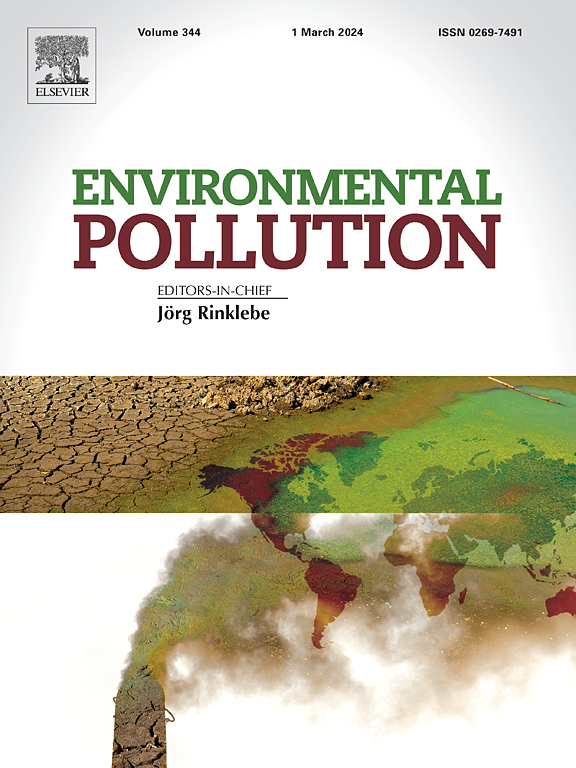在肥料改良的农业土壤中,莫比洛姆菌在抗生素抗性组的响应性传播中占主导地位
IF 7.6
2区 环境科学与生态学
Q1 ENVIRONMENTAL SCIENCES
引用次数: 0
摘要
农药越来越被认为是农业生态系统中抗生素抗性基因(ARGs)传播的新驱动因素。半衰期较长的农药往往对土壤微生物群施加持续的压力,但ARG传播的选择仍然被忽视。以广泛使用的长效除草剂农沙芬为研究对象,研究了在施用或不施用有机肥的农业土壤中应用ARGs的推荐剂量选择。空白土壤和加粪土壤中氟沙芬的降解半衰期分别为35.77 ~ 124.00和20.00 ~ 73.27 d。暴露42d后,暴露浓度为1和5 mg/kg的有机肥改良土壤中ARGs总丰度分别比对照高1.20和1.36倍,移动遗传因子(MGEs)变化量达到1.24 ~ 2.22倍;空白土壤无明显变化。此外,在肥料改良土壤和空白土壤中,细菌群落和携带arg的宏基因组组装基因组在肥料选择下均未发生显著变化。变异划分分析表明,24.42% ~ 25.41%的ARGs变异可由MGEs单独解释,而细菌群落仅能解释13.47% ~ 13.75%的ARGs变异。总体而言,这些研究结果表明,mge介导的水平转移在肥料改良的农业土壤中占主导地位,并强调了重新评估肥料和长效除草剂联合施用的农业实践的紧迫性。本文章由计算机程序翻译,如有差异,请以英文原文为准。


Mobilome dominates fomesafen-responsive dissemination of antibiotic resistome in manure-amended agricultural soils
Pesticides are increasingly perceived as emerging drivers in the spread of antibiotic resistance genes (ARGs) within agroecosystems. Pesticides with longer half-lives tend to impose persistent stresses on soil microbiomes, yet the selection for ARG dissemination remains overlooked. Focusing on a widely used long residual herbicide fomesafen, we examined recommended dose-based selection on the dissemination of ARGs in agricultural soils with or without manure amendment. The degradation half-lives of fomesafen in the blank soils and manure-amended soils were 35.77–124.00 and 20.00–73.27 d, respectively. After 42-d exposure, the total abundances of ARGs in the fomesafen-treated manure-amended soils at exposure concentrations of 1 and 5 mg/kg were 1.20- and 1.36-fold higher than that in the controls, with the changes of mobile genetic elements (MGEs) reaching 1.24–2.22 folds; while no significant change was observed in the blank soils. Furthermore, no significant change was observed in either bacterial communities or ARG-carrying metagenome-assembled genomes in both manure-amended soils and blank soils under fomesafen selection. Variation partition analysis suggested that 24.42%–25.41% of the variations in ARGs could be individually explained by MGEs, while only 13.47%–13.75% by bacterial communities. Overall, these findings demonstrate that MGE-mediated horizontal transfer predominates fomesafen-responsive dissemination of ARGs in manure-amended agriculture soils and underscores the urgency of re-evaluating agricultural practices involving co-application of manures and long residual herbicides.
求助全文
通过发布文献求助,成功后即可免费获取论文全文。
去求助
来源期刊

Environmental Pollution
环境科学-环境科学
CiteScore
16.00
自引率
6.70%
发文量
2082
审稿时长
2.9 months
期刊介绍:
Environmental Pollution is an international peer-reviewed journal that publishes high-quality research papers and review articles covering all aspects of environmental pollution and its impacts on ecosystems and human health.
Subject areas include, but are not limited to:
• Sources and occurrences of pollutants that are clearly defined and measured in environmental compartments, food and food-related items, and human bodies;
• Interlinks between contaminant exposure and biological, ecological, and human health effects, including those of climate change;
• Contaminants of emerging concerns (including but not limited to antibiotic resistant microorganisms or genes, microplastics/nanoplastics, electronic wastes, light, and noise) and/or their biological, ecological, or human health effects;
• Laboratory and field studies on the remediation/mitigation of environmental pollution via new techniques and with clear links to biological, ecological, or human health effects;
• Modeling of pollution processes, patterns, or trends that is of clear environmental and/or human health interest;
• New techniques that measure and examine environmental occurrences, transport, behavior, and effects of pollutants within the environment or the laboratory, provided that they can be clearly used to address problems within regional or global environmental compartments.
 求助内容:
求助内容: 应助结果提醒方式:
应助结果提醒方式:


